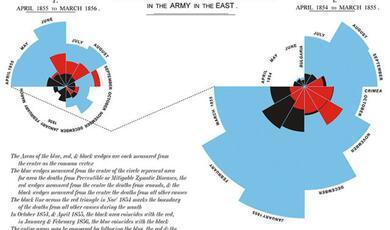100 Essential Things You Didn't Know You Didn't Know
Share
- Details
- Text
- Audio
- Downloads
- Extra Reading
This event marks the publication of John D Barrow's latest book. 100 Essential Things You Didn't Know You Didn't Know answers one hundred essential questions of existence. From winning the lottery, placing bets at the races and escaping from bears to sports, Shakespeare, Google, game theory, drunks, divorce settlements and dodgy accounting; from chaos to infinity and everything in between.
Download Text
100 Essential Things You Didn't Know You Didn't Know
Professor John D Barrow FRS
My aim this evening is to give you a rapid tour of some unusual, and perhaps for you unexpected, applications of mathematics. When people ask me to try and summarise why mathematics is interesting and why you should study it, I usually say that mathematics can tell you things that you cannot learn in any other way.
The book, 100 Essential Things You Didn't Know You Didn't Know, is deliberately rather random in the way it picks topics, so that you cannot pick and choose and decide you are going to miss one collection of topics and look at another. I am going to follow the same type of pattern this evening, and I am going to start off by referring you to a website called the Pylon of the Month. Each month, the Pylon of the Month website would display an interesting electricity pylon. They all have code numbers of some sort - Central Electricity Board 71/4137, for example - and there was always a rather romantic caption, so one might be 'ECB 94/7 watches the setting sun falling below the Mendips' or something of that style. But, one of the things you should notice if you study pylons, or maybe you are an avid student of this particular website, is that they are all made of triangles. Pylons are like great totems to the god of the triangles. You sit on the train between London and Cambridge, very often as I do, and you watch the pylons go by, and you will notice they are all made of triangles. So why is this?
Well, triangles are rather unusual. If you pick particular shapes, 'polygons' as mathematicians call them, with a particular number of sides, such as squares or rectangles, and you try to make a lattice framework out of them, it will distort; it bends, it is not rigid, it can shift into another shape nearby. That unfortunate feature is true of every single polygonal structure, with just one exception, and the one exception is the triangle. So the triangle is the one rigid polygon that exists in two-dimensions, and so, if you want to build things that do not bend and distort and buckle to some extent, pylons are the things you should be interested in, or rather triangles are the things you should be interested in. So, when you look at engineering structures made of this type of fretwork, this uniqueness of the triangular structure - it is rigid, it is strong - this is why you find it everywhere in engineering structures and in all those pylons.
Well, electricity pylons can cause fires, so let us move on and think about fires?
There is another simple geometrical property that is all around you and you may not have noticed it, and in fact, sometimes it can be rather dangerous at the health and safety level. Suppose you have a big rectangle and you are interested in the length of the perimeter. If you cut it in half, into two pieces, the resulting two pieces have a bigger boundary than the single piece would have had, because these two new boundaries have come about, whereas everything else around the outside is exactly the same. So you can see the general pattern here: if we divide the pieces up into smaller pieces again, you get even more boundary, and so on. The smaller the pieces, the more division that goes on, the more boundary that you have.
If they were three-dimensional objects, if they were cubes, and you split them up into smaller cubes, you would have more and more surface as you made smaller and smaller objects. Under certain circumstances, that can be a rather dangerous thing, because if you are worried about when things catch fire, what matters is how large is the surface area, because that is where the combustion takes place, that is where the fire can feed off the oxygen in the air around about. So if you have an old warehouse that is full of dusty old things, that dust is particularly dangerous. You might be armed with a fire extinguisher or a hose and you burst into this old warehouse, everything is burning at a low level, you turn on the hose, it blows all the dust into the air, and everything burns much faster, in fact, almost explosively.
Why is that? Well, it is the same principle that we have just seen, that once things start to break up into smaller pieces and ultimately into grains of dust, there is more surface area in the small grains, and so the fire is much more rampant and potentially explosive. So that is why London Underground want to clear away dust below the escalators: it was the cause of the King's Cross fire. It is a simple geometrical property: breaking things into smaller portions increases the surface area.
Next, looking forward to the Olympics, let us think a bit about some sporting applications of mathematics, and there are very many. Something that looks rather alarming is this high jump technique known as the Fosbury Flop. It was introduced by Dick Fosbury, who later became an engineer, in 1968 when he invented a new high jump technique where, instead of remaining upright and kicking your legs over the bar, you turn as you jump so that you arch your back and go over the bar horizontally and land on your back. This is the type of jump used by all high jumpers now, but Fosbury used it first to win the American Olympic trials and then to win the Olympic Games in Mexico City in 1968.
The interesting question is: why would you use a technique like this in high jump? Before 1968, you would not have used it at your school sports anyway. You can see, sand pit landing area is not a great and so it was not a great idea to use this technique or else you would have hurt yourself. But today, every top class high jumper, from county sports level to the Olympic Games onward, uses this technique. There is a mechanical reason why it is nice, and there is also a coaching reason - it is rather easy to learn compared with the straddle techniques, which require much more body movement to control.
If you look at it from the point of view of rather simple mechanics, the key is that if you have an object, say like a banana, that is bent like our high-jumper is mid-jump, you will find that the centre of gravity is somewhere near the centre of the object. But with this curved object, the centre of gravity does not have to lie inside the body of the object. The centre of gravity of a high-jumper, mechanically, is in fact somewhere between his head and his heels, below the arch of his back. So, under the force of gravity, he behaves as though he is a point, with a mass equal to his body mass, located below his body as it passes over the bar. What that enables him to do is to clear the bar, even as his centre of gravity goes underneath the bar. But in your school sports, long ago, when you tried to high jump, you used a rather different technique, a sort of scissors technique where your whole body goes over the top of the bar and your centre of gravity goes over the bar as well. So, from a mechanical point of view, you are transferring your kinetic energy of motion as you run in to lift, and that means gravitational potential energy, and what that energy can be is your weight, your mass, times the acceleration due to gravity, times the height that you can raise your centre of gravity:
Launch Kinetic Energy = M x g x H
H = height of centre of gravity is raised
So if you can send your centre of gravity under the bar, you use your energy much more effectively. You can get your body rolling over a much greater height than if you insist on taking your whole centre of gravity over the top of the bar. So this is the mechanical reason for these sorts of techniques.
So that is a consideration of centre of gravity in sport and movement. Another, slightly less obvious one, is the question: why do tightrope walkers use and carry long poles? If you stop the average person in the street, or even the average engineer in the street and ask them, they will usually give you an answer which is not right. They think it is something to do with centre of gravity, which we looked at just now, but holding this pole up here actually makes your centre of gravity a little bit higher, so it makes things worse, from that point of view. True, you can in effect shift where your centre of gravity is a little bit, but it is not centre of gravity that is the key here. It is something which, in mechanics and physics, is called inertia. Inertia is different from your weight. Inertia depends on the distribution of your weight, and it determines how easy it is for you to be moved or to roll or to wobble.
Suppose we have two balls, one solid and one hollow, and suppose that they are the same size and have the same mass and weight, so they are made of different material, so one is a shell and one is a sphere. If you did not know which was hollow and which was solid, if you wanted to find that out, the way you could do it is to roll them down a slope, make them wobble, spin them around, and you would find that the shell has greater inertia. This means that it would be harder to move than the solid sphere.
So what inertia is, it is determined by the distribution of mass; the more mass there is far away from the centre, the higher the inertia. So the shell has all its mass far from the centre, at the surface, and so it has higher inertia. Mathematically, what we mean by inertia is the mass of the object times the square of its size, times some factor which tells you how the mass is concentrated. So, for the solid sphere, that concentration factor is two-fifths, whereas for the shell, it is two-thirds, so it is bigger than two-fifths:
Inertia = Mass Spread x Mass x Radius2
Inertia = C ´ M ´ R2
Hollow Shell Inertia = 2/3
Solid Sphere Inertia = 2/5
So the same idea really governs what is going on with a tightrope walker with their pole. In effect, by holding the pole, they move lots of mass far away from your centre, because of the mass in the pole. By doing this, you are increasing your moment of inertia and so you wobble slower than you would if you did not have the pole. So, without the pole, if there is a little bit of wind or you miss your footing, you will wobble rather quickly, and it will be difficult to recover. By holding the pole, you give yourself time to re-find your footing and you wobble slower. So that is all that is going on here: you are increasing your inertia, you are wobbling slower, and therefore, you are more stable.
This type of principle pops up in all sorts of other situations. For instance, you notice that speed cyclists, when racing on the tilted tracks of velodromes, are on bicycles which have wheels which are not like your normal cycle wheels. They are solid, so they are not spoked and hollow. Of course, if you tried to cycle home with a bike like that, on the road, there would be disaster, because as soon as you turned the wheel slightly to the right and the left, the oncoming wind would blow your wheel around. So he is on a banked track, he is keeping the wheel at 90 degrees to the surface all the time, so he is never steering, in effect. But why the solid wheel?
We have already discovered that a solid disk has a lower inertia than the hollow rim. So by having these solid wheels, the wheels will respond faster to the pedal power than if you had an ordinary cycle wheel.
This is why you occasionally see cyclists on the road with the front wheel conventionally spoked but the back wheel solid. Because of this problem with the air resistance spinning the wheel to the side, his front wheel is hollow, has a biggish inertia, but his back wheel is solid, because that is not going to respond to the steering.
Wheels are effectively two-dimensional objects. When you have a three-dimensional object, then inertia becomes more complicated in an interesting way, because a three-dimensional object has got three different axes about which it can move, and it is possible for the inertia or rotation around one direction to be different to what it is in the other two. Of course, this is more pronounced when objects are irregularly shaped. For instance, if we were to spin a rectangle along the axis of its length, you would not meet much inertia as the mass distribution is not spread out very much. But if we spin it along the axis of its width, there is a much bigger inertia because the mass is much farther from the centre. We could also spin it around at an angle half way between those previous two, so that the inertia is bigger than one, but it is smaller than the other one. It is a remarkable property of rotation of three-dimensional objects, that rotation about the intermediate axis of inertia is always unstable. So if I spin an object along the conventional axes, in line with its shape, it will just spin round and it will not do anything very interesting. But if I try and spin it about a different axis, we will get interesting outcomes.
So if you watch gymnasts at the Olympic Games on the beam or something like that, you will notice sometimes, they will do a somersault on the beam and land, they always end up facing a different way to how they started. They probably get extra marks for adding this twist, but it is unavoidable: it is this instability being introduced into their motion.
There was a rather serious example of this instability occurred with the Mir Space Station. It was not publicised much at the time, but there was nearly a total disaster in space, which would have ended up with a quarter of a million tons of debris in near-Earth orbit and therefore bring an end to an awful lot of near-Earth space activity.
The Mir spacecraft was constructed bit by bit like a giant Lego kit, but what happened to it was a catastrophe. There was a docking spacecraft coming to join it, to bring more supplies and food, and it was rather badly controlled. The British/American astronaut on board at the time, Michael Foale, told me that driving these small spacecraft is rather as if you were driving along the motorway and you want to slow down, then if you put your foot on the brake and you would slow down in twenty minutes' time. So the inertia of the spacecraft is so enormous, you have to apply the controls an extraordinary long time before you want a manoeuvre to happen. There was obviously a miscalculation, because the docking craft smashed into the Mir spacecraft. What that resulted in was it started the spacecraft spinning, very slowly. Foale and the other astronaut retreated into the escape capsule at one end. If they used it, they were essentially abandoning the spacecraft, and who knows what would happen. So they had to stop it spinning. They had some rockets that they could fire in chosen directions, and so the question was what should they do? If they fire it in the wrong direction, they could start the spacecraft spinning around that intermediate axis, and then it would flip over and break apart, and they would have a total disaster. If they ended up firing it in another direction, they could do something that was also bad: it could be locked into a completely stable configuration where they would never be able to manoeuvre it out.
So Foale asked Mission Control back in the US what were the moments of inertia; what were the different inertias of the spacecraft around three axes. Nobody had a clue, because nobody had ever thought in that way about the spacecraft. But he had a little early generation Apple Mac on board, and so people just radioed up the plans of the spacecraft, and he had to spend a day or so calculating what he believed to be the moments of inertia, putting them in the equations of motion, solving them, and discovering what was the special direction in which you could safely fire the rockets so that you stopped the rotation without passing through the unstable rotation axis. He successfully did that, and saved the space station. So knowing these things can actually be very useful, in all sorts of everyday circumstances?!
I have another interesting application of maths to everyday things. This is not in the book, but it was something that occurred to me while I was away in Lapland with unlimited hours of daylight to while away. It is a simple application of mathematics to rowing.
So if you look at rowing eights, you notice how people tend to rig the boat. The pattern of the oarsmen is that they alternate one side to the other side with their oars. There is a particular configuration that is the commonest, and usually that is called the standard rig, and it is the one you will tend to see in the Boat Race or any other boat races.
From a mathematical point of view, there is something that is very odd about that way of arranging the oarsmen in a boat. What we need to do is to consider the forces here, because the oars on one side of the boat can be broken down into two components. One component is the force that drives the boat forwards, but the other component acts at 90 degrees to that one and acts perpendicular to the direction of the boat. But the oars on the other side of the boar have the same two components to their rowing force, but the component which does not contribute to the propelling of the boat is directly opposed to the non-driving component of the rowing of those on the other side. So there is a component of the rowing on each side of the boat which is useful and the other is not useful and cancels out with the rowing on the other side.
What is interesting about forces are things called moments. Remember what Archimedes taught us: if you want to figure out where the balance point is, you hang a weight on either end, then you get the balance by multiplying that distance by the weight on one end and getting it equal to the distance times the weight on the other end. So this is called the moment of that force, and the moment of the weight on one end tends to pull it in one direction, whereas the one on the other end pulls it in the opposite direction, but they have to be equal for there to be equilibrium.
Suppose we work out the moments of the forces on the boat. Well, we have got some distance here from the stern for each of the rowers, who row on alternate sides. Since we are only concerned with the moment, we only have to worry about the components of the forces that act at 90 degrees to the boat. These will be acting in different ways according to which side of the boat you are on, so we can call one side positive and one side minus. We can work out the moment for the rower nearest the rear of the boat as the distance from the stern, S, multiplied by the force, N, which would be negative or positive according to which side the rower was on. If the oarsmen are distance R apart, the moment for the next person, who's oar is on the other side, is N times his distance, S, plus R. The moment for the next person, on the other side, is S plus 2R. For the last person in a four-person boat, it is S plus 3R. So the sum of the moments about this point being exerted on the board is:
-Ns + N(s+r) - N(s+2r) + N(s+3r) = +2Nr
The striking thing is that it is not zero. It is 2N, the force, times the distance between the rowers. So what that means is that, half a stroke later, when the force N reverses, the moment reverses and becomes minus 2NR. So if in the first half of a stroke, the boat has a force one way, second half, it has a force the other way, the boat is going to wiggle, so if it has no cox, it is going to wiggle from side to side, or the oarsmen have to compensate for this by slightly changing the force patterns that they exert. So this is a very odd way to set up a racing rowing boat, from these configurations alone.
Now, in the early 1960s, there was an interesting story in Italy, on Lake Como, with the top Italian cox-less four who were associated with the Moto Guzzi Club. This is the famous engineering company that, in effect, invented motorboats, makes motorcycles and so forth. One day, the four were to go down to Lake Como to do their trial ahead of the European Championships. For one reason or other, and it is not clear whether this was some sort of joke on the coach or just an accident, the crew rigged up the boat in a different way: they had the front and rear rowers on the same side, and the two middle rowers on the opposite side. When the coach arrived and saw this, he was rather annoyed, and told them they were going to have to row the trial, he had a target time and they were going to have to row it in this configuration, and if they missed the target time, they were just going to have to row the trial all over again around 15 minutes later.
So they rowed the trial, but they broke their course record! So the Moto Guzzi engineers had a look at what was going on here, and one of them deduced that what was going on is that this is a very efficient situation - because there is no moment on the boat. We can see this if we are to feed it back into our earlier formula:
Moment = +Ns - N(s+r) - N(s+2r) + N(s+3r) = 0
We can see from this that there is no net moment force on the boat in this configuration. They went on to win the European Championships that year, and I think, two years later, won the Olympic Games as well.
You can explore the situation with eights. Of course there is a cox there to do some steering, but there is a configuration like this that has no moment. It turns out the Italians discovered one formation soon afterwards and used it for their eights. Some years later, the German international crew used a different configuration, which has zero moment. But I found a third one, which also has a zero moment. So, if you are rowing down the river in the next few weeks, and you see some people with unusual configurations in force, some mechanical thought as to what is going on can sometimes pay off.
The last main topic I want to talk about is something to do with surveillance and mathematics. Suppose that you had an art gallery, and you were interested in having surveillance cameras or guards who were going to keep an eye on everything, and you want your guards to be such that they are able to see every single wall and room interior in the gallery, and you know how many walls the gallery has, how many corners, what is the smallest number of guards that you can get away with? Guards' salaries are relatively large and if you can save a guard, with a bit of thought and analysis, that could save you a fair bit of money.
This is an interesting little problem to think about mathematically. If we confine our attention to galleries which are polygons, so the walls are going to be straight, if all the corners point outwards, so it is what mathematicians call a convex polygon, then you can see pretty easily that one camera is always going to suffice, assuming that when we talk about cameras or guards here, we are imagining that they have call a full 360 degree swivel, that they can see around them in every direction. So you can put one guard in such a gallery anywhere and they will be able to see every point. We are assuming there is nothing else in the way. You can modify these results if you have things in the way.
But what if your gallery is rather unusual, perhaps like Balboa Gallery, where it is not convex? A non-convex object is one where you can draw a straight line from one point in its interior to another and the straight line goes outside its boundary. Suppose it has got N corners and N sides: how many cameras do you need to keep an eye on everything?
When you see a problem like this with polygons, if you are a geometer or mathematician, it immediately signals triangulate, so we are back to our friends the triangles again. What do I mean by that? If you have got a straight-sided polygon, with any shape you like, you can always split it up into triangles. There may be more than one way to do it, but there is always at least one way to split the shape up into triangles.
What do we know about triangles? It is one of these convex polygons, so you would be able to put one camera in each of those triangles and it would be able to keep an eye on every point within and on the edge of that triangle. So if we did that, that would certainly be an answer to our problem, but it may be overkill because you could imagine it would be possible that you could keep an eye on two triangles at once, if you were in the right spoke.
What you do at this point is to use a little bit of mathematics. We here have a situation where you just drop one camera inside each triangle, but let us think out how we would economise a bit. The way to do this is to pick three colours and to assign a colour to each corner. So we start in one spot and the one rule is that the colour on the other end of a line from another corner of the triangle has got to be different; no two corners of the same colour can be connected by a line. This is called a 3-colouring. Again, this is always possible for triangulation, there is always three-colouring, and there may be more than one. After we have done that, we can count up how many was have of each colour. What you then do is that you pick the smallest of these colourings and that is going to tell you how many cameras you will need in the worst case scenario.
But what is the rule here? If you have got N sides, you divide that by three, and then you take the whole number part of that. So if we have 19 sides or corners, we would divide that by three, and you would get six and a third. The whole number part of that is six, which is our answer. So that is the general rule: for any gallery of this polygonal sort, the whole number part of a third times the number of walls tells you the number of cameras which is always sufficient, and sometimes necessary, to guard the gallery. The 3-colouring tells you where you should put them. This theorem was proved a long time ago now, in the 1970s, by Chvátal, who is a computer scientist, now working in Canada.
Let us pick a gallery that has one hundred walls or corners, then you are going to need 33 guards or cameras to keep an eye on everything in the worst case scenario. Of course you do not necessarily need that number. If it is convex, you will get away with one. So 33 is only how many you would need in the worse configuration. What does the worst configuration look like? It looks something like a comb: galleries which have these configurations, where, if you are keeping an eye on one segment, you cannot see any other one. These are going to be the type of shapes where you need the full complement of n/3, whole number part of, guards. So, in this case, if you have 100 sides, 100 corners, you are going to need 33 guards.
If you were building a gallery and you came and sought my advice and said, 'How could we economise on the number of guards and cameras?' there is two pieces of advice I could give you. The first is to build a gallery where all the corners are right angles, so do not have any concave shape configurations, because if you have a gallery where everything is a right angle, a so-called orthogonal gallery, then, pretty obviously, instead of dividing it up into triangles, you can always divide it up into rectangles, and each rectangle requires only one camera to keep an eye on the inside. But of course, there are four sides to a rectangle, so you should be able to convince yourself that instead of the whole number part of n/3 guards, you just need the whole number part of n/4. So, in this case, if you have 100 sides or corners, you do not need 33 guards now; the maximum you could ever need would be 25. So this is a lot of salaries or a lot of camera purchases that you can save.
Most galleries, in fact, if you go and look at them around London, adopt a different strategy. They have a type of configuration where they are divided into rooms. So the whole shape is rectangular, and then it is divided into rectangular rooms so that there are doorways or open archways between the two. You can see that if your guard is sitting on his seat at the entrance between two rooms, he or she can keep an eye on two rooms at once, and so this type of configuration always requires exactly the whole number part of a half the number of rooms in terms of guards or cameras. So, in the case where there is eight rooms, you are going to need four guards, located in the arches. So this is a much more economical set-up from the point of view of salaries and guards.
This type of analysis generalises in all sorts of ways that you can imagine, and even some that you cannot. If you start putting obstacles in the middle of the rooms, if you allow the guards to move around, if you put some mirrors on the walls so that one guard can keep an eye on more than one place from his single location, then there are analogous results that you can prove.
There are also curious sort of art thief theorems. So you might want to know, if you are an art thief, what the shortest route is that you could take through a gallery so that you are not visible by any of the security cameras, and there is an analogous security theorem that says how you should locate the cameras so that anybody moving through the gallery, on any path, must become visible to at least one of the cameras. So when you wander around our CCTV-ridden world in London, there is some mathematical background to the location of some of those cameras.
Finally, I wanted to show you a list of numbers that I always find rather sombring. It was a little description, that was created back in 1990 by an American environmentalist called Donatella Meadows, and it became known as the picture of the global village. It is the last story in the book, just as Pylon of the Month was the first, and so it is appropriate to make it the last example that we look at in this talk. It shows how picking the right type of mathematics, producing numbers on the right scale, can be both impressive, pertinent, and rather salutary.
So what Meadows did was to imagine that the whole world was a village in which there were just 100 inhabitants, and then, just by looking at the statistics, reduce them to fractions of that simple 100. So, in our world with 100 villagers, 57 of those villagers will be Asians, just 21 will be Europeans, 14 will be in the Western Hemisphere - that is essentially America, North and South, and there will be just 8 Africans. 70 of the villagers are non-white and just 30 are white. Only 6 of the villagers possess 60% of the entire wealth of the village, and all those 6 are from the USA. 30 of the villagers live in sub-standard houses. Only 30 can read. Half of them are malnourished. One of them owns a computer. Only one of them had a college education. This is a sobering picture of the world, but I hope you agree it shows how choosing the way you use mathematics and arithmetic to represent it can highlight and dramatise it in a rather powerful and important ways.
© Professor John D Barrow, 13 May 2009
This event was on Wed, 13 May 2009
Support Gresham
Gresham College has offered an outstanding education to the public free of charge for over 400 years. Today, Gresham College plays an important role in fostering a love of learning and a greater understanding of ourselves and the world around us. Your donation will help to widen our reach and to broaden our audience, allowing more people to benefit from a high-quality education from some of the brightest minds.


 Login
Login







